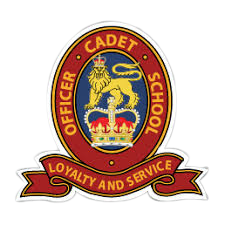List of Books
| Book Title | Author | Class |
|---|---|---|
| General OCS Books | ||
| Loyalty and Service | Neville Lindsay | |
| A Collective Memory: Life as an Officer Cadet at OCS Portsea: July 1983-June 1984 | Phil Watson | June 1984 |
| The Last Knight: A Biography of General Sir Phillip Bennett AC, KBE, DS | Robert Lowry | December 1966 |
| Life After Portsea | ||
| Pilgrim Days: From Vietnam to the SAS | Dr Alistair Mackenzie | December 1967 |
| Canister! on! Fire! Two-Volume Box Set | Bruce Cameron | June 1969 |
| Heads Up Gentlemen: A Life of Action and Adventure | Ben Lans | June 1969 |
| From Vietnam to Timor. Misfits, Missionary and Mercenary | Rob Patterson | June 1969 |
| Exit Wounds | John Cantwell (OCS) and Greg Bearup | December 1981 |
| Operation Orders. The Experience of a Young Australian Army Officer 1963 to 1970 | Pat Beale | December 1958 |
| Tiger men: An Australian soldier's secret war in Vietnam | Barry Peterson | December 1954 |
| We Band of Brothers | Brian McFarlane | June 1952 |
| Vietnam Vanguard | Ron Boxall and Robert O'Neill | December 1959 |
| Through the Wire | David Savage | December 1963 |
| History of 1 Field Squadron Group, Royal Australian Engineers, SVN, 1965 - 1972 | Brian Florence | December 1952 |
| Vietnam Anzacs Australians and New Zealanders in the Vietnam War | Tony Howell | June 1964 |
| The VietCong D445 Battalion: Their Story | Ernie Chamberlain | June 1965 |
| Out of the Ammo Box | Robin McBride | June 1968 |
| 9th Battalion, Royal Australian Regiment 'Proud to Serve' | Brian Vickery and Bert Hoebee (OCS) | June 1968 |
| Books on Military History | ||
| The Borneo Graveyard | John Tulloch | December 1966 |
| ANZAC Cove to Afghanistan: The History of the 3rd Brigade | Glenn Wahlert | December 1969 |
| One Shot Kills: A History of Australian Army Sniping | Glenn Wahlert | December 1969 |
| The Western Desert Campaign 1940-41, Second Edition | Glenn Wahlert | December 1969 |
| Exploring Gallipoli: An Australian Battlefield Guide | Glenn Wahlert | December 1969 |
| The Other Enemy? | Glenn Wahlert | December 1969 |
| Desert Anzacs the under told story of the Sinai Palestine Campaign 1916 - 1918 | Neil Dearberg | December 1969 |
| The Tiger Tea Club | Harvey Fewing | December 1967 |
| Our Secret War. The Fourth Battalion The Royal Australian Battalion. Defending Malaysia Against Indonesian Confrontation, 1965-1967 | Brian Avery | 2001 |
| In The Anzac Spirit, The Fourth Battalion, Royal Australian Regiment/Nz (Anzac), South Vietnam 1968 To 1969 | Brian Avery | 2002 |
| We Too Were ANZACs. The Sixth Battalion, Royal Australian Regiment/NZ (ANZAC) South Vietnam 1969 to 1970 | Brian Avery | 2004 |
Read below for a more detailed description of the books.
Books on the Officer Cadet School, Portsea
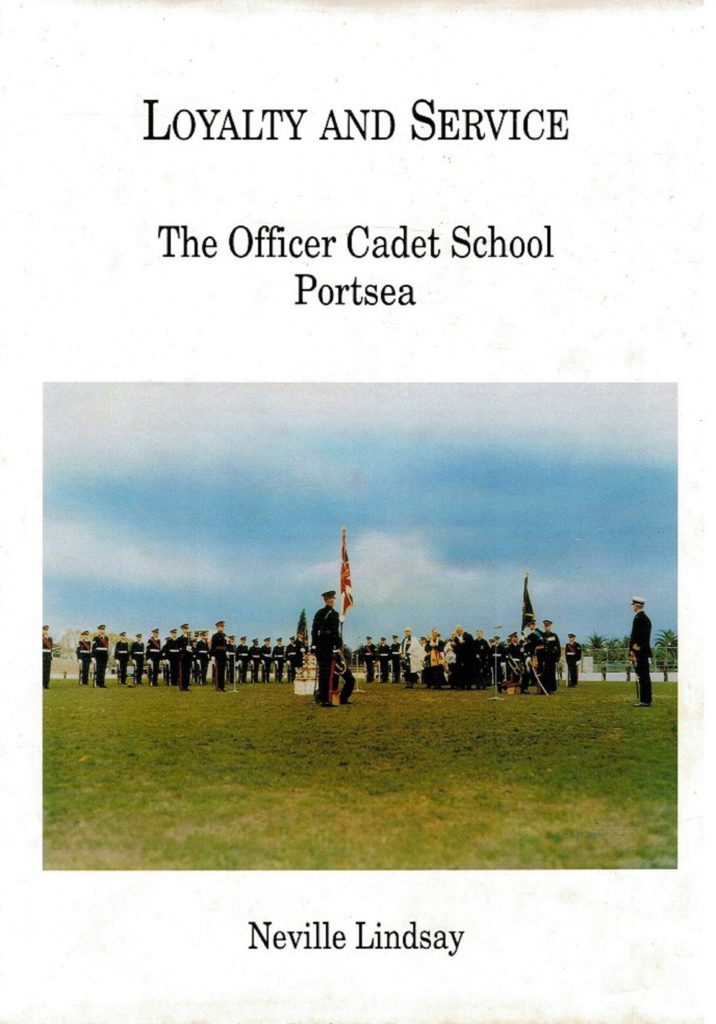
Loyalty and Service by Neville Lindsay.
The need for adequate training for the Australian permanent officer corps was the subject of wide consensus from the mid-1880s, but practicalities precluded consummation of this goal until the expansion under Universal Service brought establishment of the Royal Military College Duntroon in 1911.
This satisfied the need until the establishment of a substantial Regular Army after World War 2, followed by reintroduction of National Service in 1951 with a consequential expansion of the Citizen Military Forces. These all demanded an officer structure which could not be met through the four-year Duntroon pipeline.
The Officer Cadet School Portsea, with an initial six month course, was the solution to bridge a critical deficiency in regimental officers. But the ongoing expansion of the Regular Army, and its widening commitments in South East Asia, created a longer term demand which outlived the National Service requirement: an expansion of the horizons of Portsea’s graduates as an integral part of the career officer mainstream led to extension of the course to a full year to match that of Duntroon without the latter’s tertiary academic content.
The overall result saw the Portsea graduates take their full place in the command, training and administration of the Army, graduates serving with distinction at home, abroad and at war in all arms of the service. But after nearly thirty years of operation, the opening of the Australian Defence Force Academy to provide a tri-service college for academic studies reduced the role of Duntroon to that of Portsea, and both obviously could not survive. As the oldest institution, Duntroon remained, with the Officer Cadet School tradition absorbed into it, just as both their graduates had merged in the Army. The spirit of Loyalty and Service lives on.
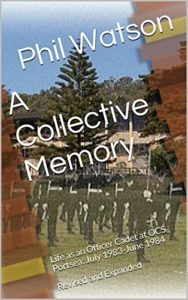
A Collective Memory: Life as an Officer Cadet at OCS Portsea: July 1983-June 1984 Revised and Expanded by Phil Watson
A collective memory of life as an Army Officer Cadet at OCS Portsea from July 1983-June 1984.
This book is available in PDF format and can be downloaded here.
Or read it online here.
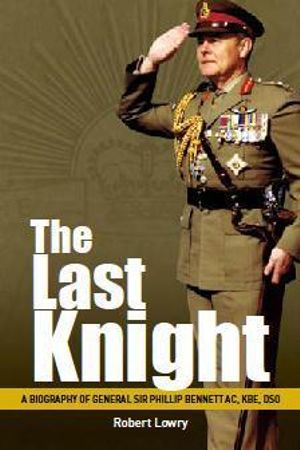
The Last Knight: A Biography of General Sir Phillip Bennett AC, KBE, DSO by Robert Lowry (OCS Class of Dec 66).
While this book is mainly about General Bennett broader career, his association with OCS goes to his time as Senior Instructor and then the first Chief Instructor from 1962 to 1965.
General Sir Phillip Bennett is a good example of what makes a great leader. With a good combination of innate personal qualities, education, broad experience and the hardening that comes with survival on the battlefield he
prospered. As a young officer he survived the first and most perilous year of the Korean War, including the Battle of Kapyong. He also withstood the rigours of battalion command in South Vietnam in 1968-69, including the Battle of Coral, one of the most intense operations of the war in South Vietnam for the Australian forces. Bennett’s story is not only one of great battles and heroic exploits, but also a story of the contest for ‘policy dominance’ between the civil servants and the military leadership illustrating what was involved in forging the foundations of the Australian Defence Force we have today. He was also a marker of changing times as the first post-Second World War officer and the last Korean War veteran to reach the most senior ranks as well as the last Chief of the General Staff to be knighted. He was the last knight to command the Australian Defence Force. Phillip Bennett’s story is characterised by dedication, tragedy, luck, and great achievement. His career spanned the evolution of the post-Second World War Army and the bureaucratic tensions that followed the demise of the separate departments of Navy, Army and Air Force, the centralisation of defence policymaking within the Department of Defence, and the formation of the Australian Defence Force. This is his life; the story of The Last Knight.
Books on life after Portsea
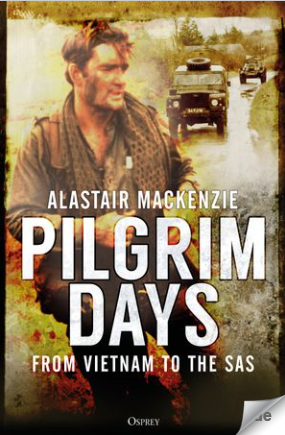
Pilgrim Days: From Vietnam to the SAS by Dr Alastair MacKenzie, a NZ graduate of the OCS Class of Dec 67.
‘We are the Pilgrims, master; we shall go, Always a little further; it may be, Beyond that last blue mountain barred with snow.’
If there was ever anyone who went a little further, a little beyond, it was Alastair MacKenzie. In a career spanning 30 years, MacKenzie served uniquely with the New Zealand Army in Vietnam, the British Parachute Regiment, the British Special Air Service (SAS), the South African Defence Force’s famed ParaBats, the Sultan of Oman’s Special Forces and a host of private security agencies and defence contractors.
MacKenzie lived the soldier’s life to the full as he journeyed ‘the Golden Road to Samarkand’. This extraordinary new work from the author of Special Force: The Untold Story of 22nd Special Air Service Regiment (SAS) vividly documents, in a detail that stuns, the experience of infantry combat in Vietnam, life with the Paras, the tempo of selection for UK Special Forces, covert SAS operations in South Armagh and SAS Counter Terrorist training on the UK mainland, vehicle-mounted Pathfinder Brigade insertions into Angola and maritime counter-terrorism work in Oman.
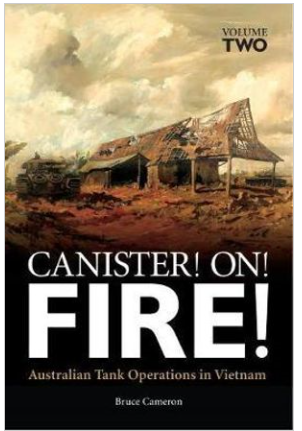
Canister! on! Fire! Two-Volume Box Set by: Bruce Cameron – a graduate of the OCS Class June 1969.
Exceptional Two-Volume (One and Two) Box Set tells the little known story of the Australian tanks in the Vietnam War.
“You can take all of the popular stuff that has been produced about our involvement in South Vietnam & none of them compare to your scholarship, passion for your subject or the sheer readability of your narrative.”
Canister! On! Fire! tells the remarkable, but little known story of Australian tanks in the Vietnam War. Based on twelve years of research, including personal letters and diaries, extensive searches of official records and numerous interviews, this book brings to life a previously unheralded aspect of the conflict. It is the story of a select group of soldiers, both regular and conscript, serving their country against all odds.
The 53-tonne Centurion tanks were not only involved in intense fighting in conjunction with infantry and artillery to capture enemy defences and defeat attacks, but also fought their own battles against enemy mines, ambushes, and an unforgiving terrain and climate.
This book takes the reader inside the tanks to share the experiences of their crews in action in the jungle. We see the gunner, trying to survive the heat inside the turret, while identifying designated targets; the operator trying to maintain communications, while keeping the guns loaded; the driver, trying to see his way forward, while keeping his head down; and the commander, trying to locate enemy positions, while directing his driver and giving fire orders to his gunner. The account also reveals how the mechanics overcame extraordinary challenges to maintain the twenty-year-old tanks, while the field engineers risked their lives protecting them against mines.
In 1968, the deployment of a squadron from 1st Armoured Regiment was controversial; their Centurions were considered totally unsuited to jungle warfare. Not only did the men and machines prove their worth, but they became an indispensable part of Australian combat operations. So much so, their subsequent withdrawal was equally as controversial as their deployment.
This exciting and enthralling narrative deserves to be read, not only as a military history, but also as a contemporary account of the resolute attitude of Australian soldiers often asked to do the impossible.
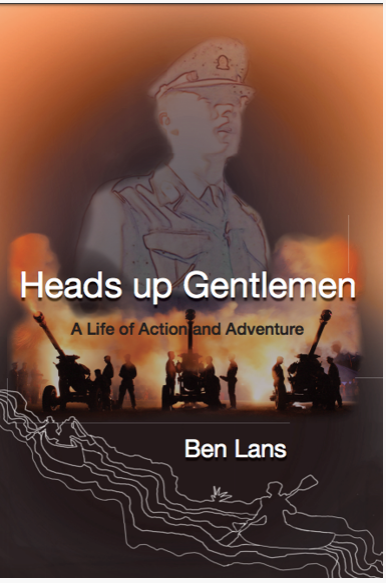
Heads Up Gentlemen: A Life of Action and Adventure by Ben Lans (OCS Class Jun 69)
These are the memoirs of Ben Lans, who joined the Army as an officer cadet with little military background and a vague military ambition to work with soldiers and seek adventure. It is a story of action and adventure during postings at home, overseas and on operational deployments…of mateship developed through shared experiences and the bonds of comradeship found in the services. It is a story that shares personal moments and humour in an environment that promotes loyalty, lasting friendships and memorable events.
Ben shares special moments of his career as he develops from a young and inexperienced officer sent to serve on operations in South Vietnam, into a leader and training developer. In addition to his Australian regimental postings, he served with, and as part of, the British Forces in Singapore in the days immediately after its independence. He shares his experiences gained during those post-colonial days of Singapore, in the early 1970s, the dawn of the new Asian age, and during training in the deep jungles of the Malay Peninsula, where elephants and tigers survived to threaten the unwary soldier. Later, as an artillery analyst in the mid-1980s, seconded and fully accredited to work for the UK Ministry of Defence in London as principal adviser on Soviet and Warsaw Pact artillery to the UK Ministry of Defence, he describes his role as part of the intriguing world that was the western intelligence community during the Cold War.
These memoirs reflect the scale, danger, risks and satisfaction associated with the planning and execution of major expeditions, such as a survival exercise on the relatively untravelled Mitchell River from the Atherton Tablelands to the Gulf of Carpentaria and whitewater adventures on major east coast rivers such as a first descent of the Herbert River in North Queensland. Ben ‘s philosophy was to include as many of his soldiers as possible in an attempt to promote group dynamics and introduce an element of danger that was missing in the training methods of the day.
The memoirs feature a detailed and riveting story of adventure and survival on Tasmania’s Franklin River, in 1980, before the river became well known to adventurers and world famous for its environmental significance. A major part of the book is dedicated to the adventures and some of the near life and death experiences of the men who served in Ben’s Battery, in their attempt to paddle the river in three separate groups in the days when not a great deal was known of the savagery and remoteness of Tassie’s wild rivers, especially for a bunch of soldiers from Townsville in Far North Queensland. Such was the drawcard of Tasmania’s wild rivers that the Army allocated a troop of helicopters to support the activity, and Australia’s ‘outdoors industry’ provided generous sponsorship and equipment. The trip featured some spectacular rescues and most of the major newspapers on the east coast, including the Weekend Australian, featured detailed articles supported by photographic spreads.
Ben thrived as a field officer and many of the memoirs are first-hand accounts of working with, and learning from, the soldiers under his command during the various regimental and instructional postings. These memoirs reflect the challenges and satisfaction of a life in the military, and adeptly unravel the perceptions that many associate with people in uniform, tackling and sometime making fun of the ‘military-isms’ that abound about the Army and demonstrating to readers that the Army was, and probably remains, an organisation with everyday people who have real and everyday feelings and emotions.
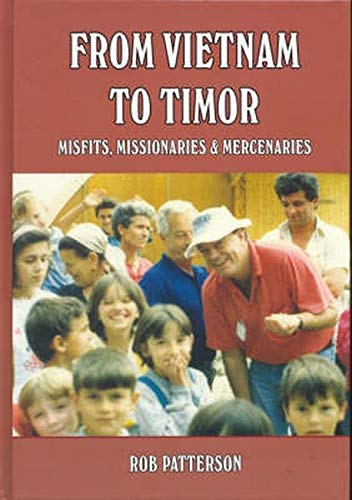
From Vietnam to Timor. Misfits, Missionary and Mercenary by Rob Patterson (OCS Class of Jun 69).
Biography of Rob Patterson who served with the Australian Army in Vietnam, retiring as a Major in 1989. Since then he has worked in Humanitarian Aid for Care Australia, the Red Cross and the United Nations. This work has taken him from Kurdistan, Bosnia, Croatia, Solomon Islands, PNG, and two periods in East Timor.
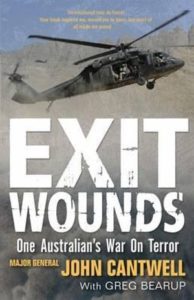
Exit Wounds by John Cantwell (OCS Class of Dec 81) and Greg Bearup.
Major General John Cantwell AO, DSC joined the Australian Army as a private in 1974. He served in the first Gulf War with the Coalition forces between 1990 and 1991, and in the second Gulf War in 2006 and 2007, where he was promoted to Deputy Chief of Army. In 2010 he served a twelve-month tour as the commander of Australian forces in Afghanistan. He was awarded a Distinguished Service Cross in the 2012 Australia Day Honours List. Cantwell retired from the Army in 2012 after 38 years of service. Co-writer Greg Bearup has been a feature writer at the Good Weekend for the past ten years and has twice been awarded a Walkley Award for his writing. In 2004/5 he took leave from his job and lived in Pakistan and filed for various newspapers including the Guardian. He also worked for the UN on various elections and lived in Syria, for the vote of Iraqi refugees, and Bamyan, in the remote mountains of Central Afghanistan.
‘This is my story, but it is also the story of thousands of Australian veterans from Iraq, East Timor, Afghanistan and other conflicts who bare similar emotional scars. This is what becomes of those men and women we send off to war, pay little attention to, then forget once they are home.’
As a country boy from Queensland, John Cantwell signed up to the army as a private and rose to the rank of major general. He was on the front line in 1991 as Coalition forces fitted bulldozer blades to tanks and buried alive Iraqi troops in their trenches. He fought in Baghdad in 2006 and saw what a car bomb does to a marketplace crowded with women and children. In 2010 he commanded the Australian forces in Afghanistan when ten of his soldiers were killed. He returned to Australia in 2011 to be considered for the job of chief of the Australian Army. Instead, he ended up in a psychiatric hospital.
Exit Wounds is the compassionate and deeply human account of one man’s tour of the War on Terror, the moving story of life on a modern battlefield: from the nightmare of cheating death in a minefield, to the poignancy of calling home while under rocket fire in Baghdad, to the utter despair of looking into the face of a dead soldier before sending him home to his mother. He has hidden his post traumatic stress disorder for decades, fearing it will affect his career.
Australia has been at war for the past twenty years and yet there has been no stand-out account from these conflicts—Exit Wounds is it. Raw, candid and eye-opening, no one who reads this book will be unmoved, nor forget its imagery or words.
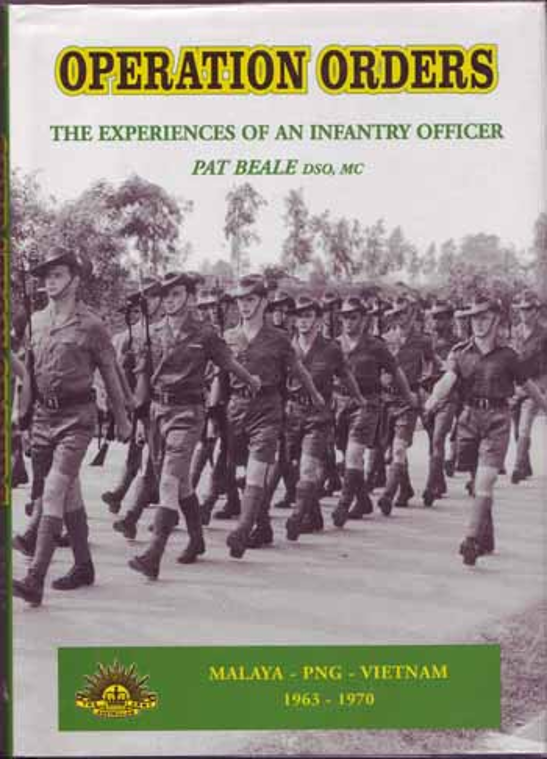 Operation Orders. The Experience of a Young Australian Army Officer 1963 to 1970 – by Pat Beale (Dec 58)
Operation Orders. The Experience of a Young Australian Army Officer 1963 to 1970 – by Pat Beale (Dec 58)
The author Pat Beale was the only Australian Major to be awarded the DSO medal during the Vietnam War. Early during the Vietnam War, as a member of AATTV Mike Force, he commanded a half Battalion of Montagnards. French term Montagnard, meaning “People from the mountains” refers to an indigenous people group generally from the Central Highlands of Vietnam. A tough group of warriors who refused to take prisoners. Beale found it difficult to restain these soldiers from old tribe traditions of souveniring the ears from bodies of foe. He took part in the Battles at Dak Seang in Vietnam. Previous to Vietnam War, he was awarded the MC medal in Borneo during the Indonesian Confrontation in 1965 and saw operational service in Papua New Guinea. These Operations are covered in this book. After Vietnam he soldiered on for another 20 years the main highlight being the command of 1 RAR Townsville between 1978 and 1980. Prior to Peter Gosgrove taking Command in 1983.
This book gives a valuable insight into Australia’s military involvement in South-East Asia and Papua New Guinea as experienced by an infantry officer. He was involved in anti-terrorist activities in Malaysia, action in Borneo during Confrontation and then in Vietnam with a Special Forces unit.
General Peter Cosgrove said of this book:
This is a wonderful evocative account of soldiering in what now seems to be a bygone era, when one could spend years of peacetime and operational service in Malaysia, Papua New Guinea and Vietnam. It is all brought to life by an author with an eye for detail, beauty and humour. Once again I could almost smell the jungle paths and the tropical vegetation. Pat Beale has given us a valuable glimpse of the human face of soldiering and warfare. The human aspect has not changed substantially over the centuries, even though the context of warfare changes. It is the reality of war and combat that should never be forgotten.
 Tiger men: An Australian soldier’s secret war in Vietnam Hardcover – 1988 by Barry Petersen (Dec 54)
Tiger men: An Australian soldier’s secret war in Vietnam Hardcover – 1988 by Barry Petersen (Dec 54)
In 1963 Barry Peterson left Australia for Vietnam to train local tribes to defend their villages against the Vietcong. This is the story of those Truong Son, or “Tiger Men, ” who became the most respected and feared native forces in South Vietnam. But it is also the sad story of the defeat and destruction of the Montagnard culture and way of life, as Vietnamese and American leadership ultimately turned its back on its loyal supporters.
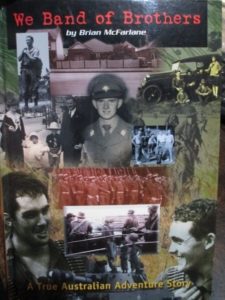 We Band of Brothers by Brian McFarlane
We Band of Brothers by Brian McFarlane
As described by one critic: “This book is gripping, has much humour, ribald and subtle, and much pathos, but understated.”
It is the story of a boy born and growing up in Sydney, who was drafted into the Australian Army at age eighteen in 1951. He remained in the army and first served overseas alongside the British Army fighting against the Communist terrorists in Malaya in the mid-nineteen-fifties. After a period as an instructor at the Royal Military College, Duntroon, he spent three years with the Pacific Islands Regiment in Papua New Guinea during the time of Confrontation with Indonesia and Indonesia’s takeover of West New Guinea from the Dutch. Following this he led an infantry company of troops in Vietnam in 1966-67 and in this well illustrated book he tells the story of those men during the early stages of the Australian occupation of Nui Dat at the time of the Battles of Long Tan and later Bribie. He returned to Vietnam in 1970 for further service there totaling 809 days.
David Black says: “…very well written, humorous, descriptive, and for a civilian, easy to understand.”
McFarlane’s military career started with Nasho training at Singleton which led to his being selected for the first intake of the Officer Cadet School at Portsea.
After becoming an Officer, he was sent to the Malaysian conflict where he commanded an infantry platoon of the 2nd Battalion RAR where he led a team of Iban and Australian trackers hunting terrorists deep in the jungles of the Malay/Thai border.
He later served as an instructor at Duntroon and 3 years with The Pacific Islands Regiment in PNG, ultimately as a company commander.
In 1966, he served in Vietnam with the 1st Australian Task Force and C Company 6RAR.
Detailed accounts of the operations carried out during his military career are provided. The narrative is supported with a huge quantity of personal printed photographs. Of special interest, is the activities at the time of the Battle of Long Tan when he was serving C Company 6 RAR.
Included in the appendices is a nominal roll of those who served with C Company 6RAR and a brief history of the battalions of the Royal Australian Regiment.
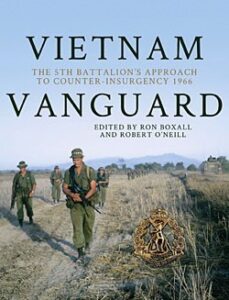
Vietnam Vanguard – Edited by Ron Boxall (Dec 59) and Robert O’Neill.
The Vietnam War, and Australia’s part in it, was a major military event, calling for willingness to face death and destruction on the battlefield on the part of those sent there, especially the men of our infantry battalions who formed the spearhead of our forces in Vietnam. For many reasons, the Australian public know relatively little about what our Army did in Vietnam during the war, particularly during the years of our peak commitment, 1965–72. This book attempts to make the true nature of the war clearer to readers, emphasising how hard fought it was during major operations. Twenty-seven of the contributing authors of this book were involved in the 1966 deployment of the 1st Australian Task Force into Phuoc Tuy Province. This formation was the first Australian Army force larger than an infantry battalion group to be deployed into a major war since World War II. 5th Battalion, the Royal Australian Regiment (5 RAR), was in the vanguard as the task force’s first element committed to operations to seize and occupy Nui Dat base and embark on establishing dominance over the enemy. The narratives presented in this book give rare insights into thoughts of the soldiers at the time and how they have come to view the Australian Government’s hurried expansion of its initial commitment to that war, the Army’s state of preparedness for that wider involvement, and how those in its forefront adapted to get the job done, both in and out of operations, despite numerous shortcomings in higher level planning. Both professional soldiers and conscripted national servicemen have contributed viewpoints to these pages.
You can read this book on line by following this link.
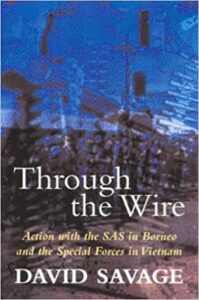 Through the Wire – A book by graduate David Savage (Dec 63).
Through the Wire – A book by graduate David Savage (Dec 63).
The United States Special Forces, the Green Berets, were often regarded as the elite of the American forces and their mobile strike force, the ‘Mike Force’, was considered the elite of these Special Forces. During the Vietnam War, the Mike Force performed an SAS-type role by working with and training Vietnamese mercenaries–the Montagnards. David Savage was one of a select group of Australians who served with the Mike Force in Vietnam. This book gives the first graphic account of the major battle at Duc Lap in which the Mike Force and the Montagnard mercenaries stopped a large North Vietnamese Regular Army offensive in August 1968. Mortar barrels and machine gun breeches glowed cherry red as they fought off human wave assaults by the North Vietnamese. All the while, they hoped that reinforcements would arrive in time to prevent the outpost being overrun. The US Army Official Historian described this battle as one of the major battles of the war and without doubt one of the most intense and furious. David Savage, an officer with the Australian SAS in Borneo, served with the Mike Force in the Central Highlands of South Vietnam.
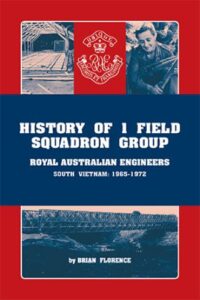
History of 1 Field Squadron Group, Royal Australian Engineers, SVN, 1965 – 1972 by Brian Florence ( graduated December 1952, Commandant 1978 – 1980)
Past Vietnam War histories have tended to record the sappers’ work as peripheral. This book attempts to highlight the skill, ingenuity, and courage they displayed throughout the entire war. It chronicles their experiences—both good and bad—that are based around their operations, with an emphasis on the personal experiences of those involved.
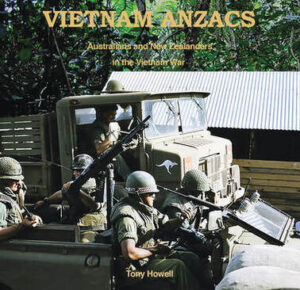 Vietnam Anzacs Australians and New Zealanders in the Vietnam War by LTCOL (RTD) Tony Howell MC (graduated Jun 64).
Vietnam Anzacs Australians and New Zealanders in the Vietnam War by LTCOL (RTD) Tony Howell MC (graduated Jun 64).
The Vietnam War was an impossible ask for the Free World forces, given the political restrictions imposed on their conduct. Hanoi’s National Liberation Front had been in place since 1946, controlling the loyalty of the peasants through a combination of political ideology, torture, murder, assassination and abduction. Hanoi’s Tet Offensive launched in 1968 was meant to result in the general uprising of the countryside. This did not happen, and none of Hanoi’s military objectives were achieved. On the political front, however, the West was surprised at the strength and violence of Hanoi’s offensive. What the US military-led forces failed to deal with was the political nature of Hanoi’s struggle. This, together with an inept Saigon Government and poorly-led South Vietnamese armed forces, resulted in a communist victory in 1975.
Within Phuoc Tuy Province and along the Province’s northern borders were D445 VC Battalion, 274 and 275 VC Main Force Regiments and 33 (NVA) Regiment. These Viet Cong and North Vietnamese Army units were well armed, well led and highly motivated. Facing these elite enemy units was the 1st Australian Task Force (1st ATF). Five designated ANZAC battalions passed through 1st ATF from 1968 to 1971 and, within these five battalions, there were nine New Zealand rifle companies.
VIETNAM ANZACS recognises the contribution of our ANZAC battalions during this most unpopular and brutal war. Each ANZAC battalion did its part to seek out and destroy the enemy within the TAOR. They faced the finest VC and NVA Main Force Regiments, battling them in the towns, villages, rubber plantations, jungle and in the M16 mine-infested VC sanctuaries and Secret Zones. The ANZACs courage in these face-to-face encounters was proven time and time again. These soldiers answered their Governments’ call and did their nations proud.
The book is written in the same style as Tony’s first book, Jungle Green Shadows, published by John Douglas Publishing in 2019. There are hundreds of maps, photos and diagrams to help the reader understand the many operations and battles fought in Phuoc Tuy Province and the northern border areas. The book also contains a glossary of terms, a list of those New Zealanders who served there on active service and a list of those who became casualties.
VIETNAM ANZACS is not a glorification of war nor does it seek to make a political statement. It simply tells the story of the ANZAC battalions, and particularly their New Zealand rifle companies, in Vietnam.
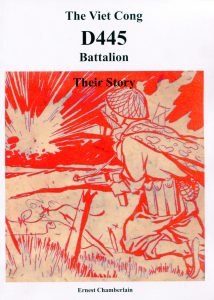 The VietCong D445 Battalion: Their Story – A book by OCS Graduate Ernie Chamberlain (June 1965). Ernie served 36 years in the ADF with language fluency in Indonesian, Vietnamese and Khmer. He was the Director of Military Intelligence and later served as the Defence Attache in Phnom Penh, and subsequently in Jakarta. From 1999, following his military service, he served in Timor Leste for several years, including as the strategic policy and planning advisor to the Timor Leste defence minister.
The VietCong D445 Battalion: Their Story – A book by OCS Graduate Ernie Chamberlain (June 1965). Ernie served 36 years in the ADF with language fluency in Indonesian, Vietnamese and Khmer. He was the Director of Military Intelligence and later served as the Defence Attache in Phnom Penh, and subsequently in Jakarta. From 1999, following his military service, he served in Timor Leste for several years, including as the strategic policy and planning advisor to the Timor Leste defence minister.
There are many books that cover this topic from and Australian perspective. This modest work on the Viet Cong’s D445 Battalion – a battalion on “the other side”, will hopefully complement those publications and the official histories – and also those of the Viet Cong D440 Battalion and the 33rd NVA Regiment.
This work of some 348,200 words presents a translation and close examination of The Heroic 445 Battalion : its History and Tradition (Tiểu Đoàn 445 Anh Hùng :Lịch Sử/Truyen Thống) – i.e. the “445 Battalion History” published in 2004. As near as possible to a literal translation of the Vietnamese text has been attempted.
The book is free-to-read on Scribd at: https://www.scribd.com/doc/306536690/The-Viet-Cong-D445-Battalion-Their-Story-and-the-Battle-of-Long-Tan . The work includes 18 discrete annexes covering a range of aspects of probable interest – including a comprehensive review of casualties at that Battle – including the personal details of 176 NVA/VC KIA; and a detailed annex on signals intelligence (SIGINT) aspects. (http://pronto.au104.org/547Sigs/547story3.html)
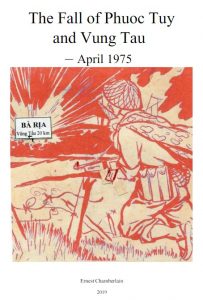 Ernie has also written some 50 Research Notes covering a variety of topics relating to to the Vietnam war. Probably the most well-received was the 78-page note (with maps and photos): The Fall of Phước Tuy and Vũng Tàu – April 1975, Research Note 7/2019, 11 July 2019 ( free-to-read on-line on Scribd at: https://www.scribd.com/document/416594424/The-Fall-of-Phuoc-Tuy-PDF-Note-7-2019 )
Ernie has also written some 50 Research Notes covering a variety of topics relating to to the Vietnam war. Probably the most well-received was the 78-page note (with maps and photos): The Fall of Phước Tuy and Vũng Tàu – April 1975, Research Note 7/2019, 11 July 2019 ( free-to-read on-line on Scribd at: https://www.scribd.com/document/416594424/The-Fall-of-Phuoc-Tuy-PDF-Note-7-2019 )
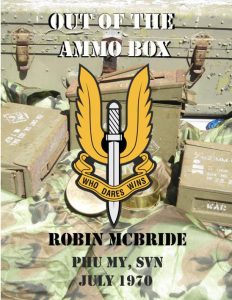 Out of the Ammo Box -A book by LTCOL Robin McBride, a graduate of OCS in June 1968.
Out of the Ammo Box -A book by LTCOL Robin McBride, a graduate of OCS in June 1968.
This is the story about an SAS Patrol in the Vietnam War. It will probably only be of interest to those who were involved, however it should be of general interest to a military reader and perhaps others.
The patrol was one of twenty which made up 1 SAS Squadron in 1970 and the story the Patrol Commander relates is typical of many SAS patrols carried out at the time.
The story depicts the thoughts, trials and tribulations plus frustrations a patrol commander goes through in preparing for and then executing the patrol mission. It also describes the thoughts, trials and tribulations and the frustrations of individual patrol members. More importantly it portrays the reliance, loyalty and dependability that each of the patrol members has with each other – these highly trained, multi-skilled and above average infantrymen who depend on each other for their life.
SAS Patrols were the ‘eyes and ears’ for the Australian Task Force based in Nui Dat in PHUOC TUY province of South Vietnam. Their information and reporting together with other intelligence, gave the Task Force Commander a basis on which to plan operations. SAS Patrols were tasked for several different missions but primarily their role was reconnaissance and surveillance.
The author, Robin McBride, has researched and travelled to bring details of their story together to produce an outstanding result.
In Robin’s words:
‘This story is a personal account of a SAS patrol during the War in Vietnam. It was a small patrol ordered to conduct reconnaissance of a likely enemy camp site, this site was a supposable enemy defended position just east of PHU MY. Before the mission was completed, the patrol was reinforced, and the mission changed from reconnaissance to an assault on the position.
In its execution of the mission the patrol was contacted out of position by the enemy, and when called upon the expected offensive air support had not been warned for the task.’
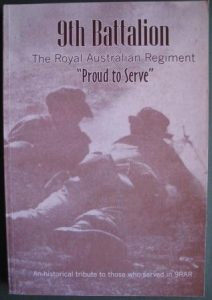 9th Battalion, Royal Australian Regiment “Proud to Serve” was authored by Brian Vickery and Bert Hoebee. Bert was a June 1968 graduate from OCS.
9th Battalion, Royal Australian Regiment “Proud to Serve” was authored by Brian Vickery and Bert Hoebee. Bert was a June 1968 graduate from OCS.
9th Battalion, The Royal Australian Regiment (9RAR) was raised on 13 November 1967 in Adelaide. It was initially based at the Keswick Barracks before transferring to Woodside. The battalion arrived in Vietnam in November 1968, relieving 3 RAR. It formed part of the 1st Australian Task Force (1ATF) and was based at Nui Dat in Phuoc Tuy province.
9RAR joined Operation Goodwood (3 December–17 February) on 1 January, 1969. Goodwood was a reaction to a perceived threat posed by an increase in Viet Cong (VC) activity that suggested an offensive was being planned. The operation took place in the Bien Hoa province. On 17 February the battalion became involved in Operation Federal (17 February–2 April), also in Bien Hoa. It was engaged in searches and patrols following the 1969 Tet Offensive. The battalion returned to Nui Dat for a period of rest from 9 to 24 March. It then rejoined Federal until 2 April.
During April 1969 1ATF adopted pacification operations as its first priority. This involved seeking out and destroying the enemy in its base areas, preventing enemy access to the civilian population, and helping to create a secure climate for South Vietnamese social, political, and military life. The work was demanding, dangerous, and monotonous and was the primary task carried out by the battalion for the remainder of its tour.
9RAR was primarily engaged with pacification operations. All but three operations took place in Phuoc Tuy. On 2 April it was deployed to the Bien Hoa–Long Khanh–Phuoc Tuy border for Operation Overland (2–10 April). On 11 April it moved south within Bien Hoa and commenced Operation Overlander (11–15 April). The battalion then returned to the Bien Hoa province for Operation Jack (30 September–31 October). These operations were reconnaissance-in-force operations, involving patrolling, land clearing, and protecting civilians.
LTCOL Brian Avery, a graduate of June 1962, has written three books that cover the Indonesian Confrontation and Vietnam.
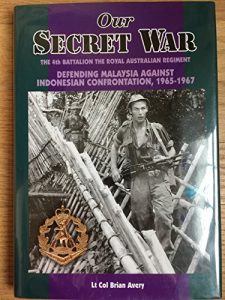
OUR SECRET WAR. THE FOURTH BATTALION THE ROYAL AUSTRALIAN BATTALION. Defending Malaysia Against Indonesian Confrontation, 1965-1967. Slouch Hat Publications, Rosebud VIC 2001
The first part of this book provides the background to the establishment of the first battalion of the Regiment to be raised in Australia, with the Raising Instruction being authorized in September 1963. (The first 4RAR was not a battalion, but rather a depot unit raised during the Korean War and later absorbed into the Infantry Centre.) 4RAR was officially raised in Woodside, South Australia, on 1 February 1964, with the express purpose of serving in Malaysia as part of the British Commonwealth Strategic Reserve. The decision was made because the Australian Army’s organization in 1963 was incompatible with the British organization. The Army would henceforth have two battalions on the larger Pentropic Establishment (just over 1300 men), and two on the British Tropical Establishment (about 780 men)
The book covers the raising and training of 4RAR in Woodside, remote from other field units and suitable training areas, in preparation for its service in Malaysia, when it relieved 3RAR in Terendak. Its focus sharpened when authority was given for Australian Forces in Malaysia to take part in the campaign against Indonesian Confrontation, and the Australian contribution was strengthened. 4RAR was complete in Terendak by 1 October 1965, and commenced training for its expected move to the Borneo State of Sarawak in April 1966 – the same area in which 3RAR had served in 1965. Between its arrival in Malaysia and its move to Sarawak, it also undertook security operations in the State of Malacca. When 4RAR arrived in Borneo, it was the only Battalion of the RAR to be without National Servicemen, although three officers and forty private soldiers undergoing training at the Jungle Warfare School, Kota Tinggi, joined the Battalion in May.
The greater part of the book relates the operational tour in Sarawak, which was largely undertaken at platoon level, operating from company bases sited close to the border. Operations in Borneo were conducted with minimal air and artillery support in very rugged terrain, compared with the scale of support available in 4RAR’s next operation tour in South Vietnam. , 4RAR also undertook Top Secret CLARET operations, patrols into Indonesian territory. 3RAR and Australian SAS troops also undertook these operations, although the 4RAR patrols were restricted to reconnaissance and surveillance to ascertain the Indonesian forces intentions and dispositions. In June 1966, a large Indonesian incursion into the 4RAR was successfully eliminated, the survivors fleeing back into Kalimantan.
4RAR lost five members during its tour in Borneo, and one member died in training in Malacca before deployment to Borneo. With the signing of the Peace Accord between Malaysia and Indonesia on 11 August 1966, 4RAR returned to Terendak, where training for the Strategic Reserve role took priority until the Battalion returned to Australia in September 1967, warned that it would be kept virtually intact for service in Vietnam from May 1968.
Included in the book is a nominal roll of all members of 4RAR who served in Borneo.
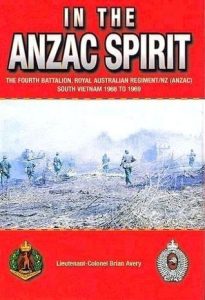 IN THE ANZAC SPIRIT, THE FOURTH BATTALION, ROYAL AUSTRALIAN REGIMENT/NZ (ANZAC), South Vietnam 1968 to 1969. Slouch Hat Publications, Rosebud VIC 2002
IN THE ANZAC SPIRIT, THE FOURTH BATTALION, ROYAL AUSTRALIAN REGIMENT/NZ (ANZAC), South Vietnam 1968 to 1969. Slouch Hat Publications, Rosebud VIC 2002
This book commences with the return of 4RAR to Australia in September 1967 at the completion of its tour in Malaysia during Indonesian Confrontation. The Battalion had been warned before leaving Malaysia that it would be relieving 2RAR in South Vietnam in May 1968. Given the limited time available to prepare for the move, 4RAR would not be stripped of its officers, Warrant Officers and NCOs on return, but would remain largely intact, receiving a draft of about one hundred National Servicemen to bring it to full strength and raise the percentage of NS men. The new CO, LtCol L R Greville, assumed command on 8 January 1968. Once complete in Enoggera after leave, 4RAR commenced training, proceeding through Battle Wing at Canungra, company and battalion level exercises and then the major test exercise at Shoalwater Bay.
An announcement made in February 1968 of the formation of the ANZAC Battalion, at the time 2RAR in Nui Dat, meant a reorganization early in the training cycle as A Coy disbanded and its personnel redistributed throughout the Battalion. It also meant that the draft of NS men would no longer be need and they were re-directed to another battalion. The book then discusses the effects of regrouping as an ANZAC battalion in greater detail. The advance party of 4RAR left Brisbane on 13 May 1968 by QANTAS charter, with the evening news relaying the details of the battle of Fire Support Base CORAL. The main body departed Brisbane on HMAS Sydney on 21 May. 4RAR officially raised its flag at Nui Dat on 1 June and assumed the title of 4RAR/NZ (ANZAC). The Battalion had retained a high proportion of its members from Malaysia and, on arrival at Nui Dat, had over 470 veterans of its tour in Borneo, including nearly all of its officers and WO/NCOs.
The book provides a detailed account of the operations of an ANZAC Battalion of five rifle companies (three Australian and two New Zealand) and an enlarged Support Company. It covers the period of operations from 1 June 1968 until it departed Vietnam in May1969. In May 1969, V Coy (NZ) returned to its parent battalion, 1RNZIR, in Malaysia, while W Coy, halfway through its tour, remained to serve with 6RAR/NZ. During the tour, 4RAR/NZ spent a total of 270 days on battalion operations, while rifle companies were involved in smaller scale operations when the Battalion was not on operations away from Nui Dat.. During the whole of its tour, 4RAR/NZ was responsible for the occupation of the Horseshoe position by a reinforced rifle company so that only four rifle companies were available for major operations. Most of the Battalion’s operations were conducted in the northern border area of Phuoc Tuy Province or in the neighbouring Long Khanh and Bien provinces. During its tour, 4RAR/NZ lost nineteen members, including four members of the Royal New Zealand Infantry Regiment.
Included in the book is a nominal roll of all members of 4RAR/NZ who served in Vietnam on the Battalion’s first tour.
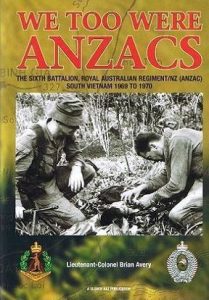 We Too Were ANZACs. The Sixth Battalion, Royal Australian Regiment/NZ (ANZAC) South Vietnam 1969 to 1970. Slouch Hat Publications, Rosebud, VIC. 2004
We Too Were ANZACs. The Sixth Battalion, Royal Australian Regiment/NZ (ANZAC) South Vietnam 1969 to 1970. Slouch Hat Publications, Rosebud, VIC. 2004
This book covers the period from 6RAR’s return to Australia to Enoggera after its first tour in Vietnam in 1967 until its return from its second tour in Vietnam to Townsville in 1970. The first chapters of the book relate the historic background to the raising of 6RAR in Brisbane in 1965 during the expansion of the Royal Australian Regiment from three to nine battalions and the introduction of National Service to meet increased commitments in South East Asia. It also includes a brief outline of 6RAR’s first tour in Vietnam.
On its return to Brisbane in 1967, it was initially quartered in Enoggera, but soon after, relocated to the newly constructed Lavarack Barracks in Townsville. On its return to Australia in 1967, as was the practice from most battalions returning from active service, it was stripped of most of its officers, Warrant Officers and NCOs, many of its experienced soldiers and of course, its National Servicemen who had completed their obligation. On 8 January 1968, a new CO, LtCol D M Butler, took command of 6RAR, with the immediate task of rebuilding for its expected return to Vietnam in mid-1969. This was not made easier by the numerous tasks the unit was required to undertake over the ensuing year. One of these tasks was a ceremonial parade in which 6RAR received its Colours. Soon after this parade, the Prime Minister, the Rt Hon John Gorton, was visiting the United States and was presented with the Citation and Streamer for the Presidential Unit Citation awarded to D Coy for the Battle of Long Tan. In turn, he presented these items to 6RAR at another ceremonial parade held at Lavarack Barracks. In preparation for its role as an ANZAC Battalion, one rifle company (C Coy) was disbanded early in its cycle. With the loss of RAInf Special List bandsmen, 6RAR raised its own band, Pipes and Drums, which was able to lead the Battalion on its farewell march through Townsville and in Vietnam would operate as stretcher bearers.
The early chapters in the book relate some of the early history of 6RAR and then cover training in detail. After undergoing its required training program and the mandatory test exercise at Shoalwater Bay, the Battalion prepared for departure for Vietnam. The Advance Party departed from Garbutt on 6 May, via Singapore, and on arrival in Saigon, were ferried to Nui Dat to begin the handover process with 4RAR/NZ. The main body of the Battalion were taken to HMAS Sydney by the ship’s landing craft and local ferries on 8 May. Arriving at Vung Tau on 21 May, the main body was ferried on landing craft to a beach and then by Chinook helicopter to Nui Dat, he returning aircraft and landing craft ferrying 4RAR for its voyage home.
The next part of the book goes into some detail on the concept of the ANZAC Battalions, operations in Vietnam and in-theatre preparation for operations. Most of the book provides details of 6RAR/NZ operations, which mainly took place in the southern areas of Phuoc Tuy Province with some effort directed to operations on the tri-border area to the north of the province. Only a fw salient points will be covered here.
By the time of arrival of 6RAR in Vietnam in 1969, the VC had learned to exploit the barrier minefield and made great use of the mines against 1ATF. Unlike its predecessor, 6RAR/NZ suffered many casualties from these mines, covered in sombre detail by the author. It was also the general policy to allow the newly arrived battalions to operate in an area where contact would be minimal, to allow them to work up their operational routines before being committed. 6RAR/NZ was deployed to a ‘safe’ area, but the enemy had not read the script. On its ‘warm-up’ operation, it just happened to be in the path of 33 NVA Regiment, resulting in major contacts (including the 5RAR Battle of Binh Ba) which resulted in the NVA fleeing Phuoc Tuy and not returning until 1971. The book provides greater detail of the any operations conducted over the tour, but of specific interest is probably the major operation during which 6RAR/NZ operated on the Mai Tao mountain, an area which the Task Force had previously avoided. The results of this operation were exceptional, clearing what had been an unchallenged base area of the VC Main Forces.
The Battalion returned to Australia after being replaced by 2RAR in May 1970. During its second tour of Vietnam, 6RAR/NZ suffered a total of twenty six fatal casualties, including twelve Australians and fourteen members of 1RNZIR. A further eight members of Australians of 1 Fd Sqn RAE and a member of 101 Fd Bty RAA died while supporting 6RAR/NZ on operations. A significant number of these casualties were a result of mine incidents, including the one featured in the song ‘I Was Only Nineteen’.
Books on Military History
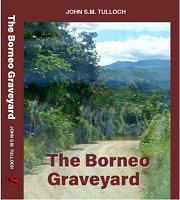
The Borneo Graveyard – A Book by OCS Graduate John Tulloch (Dec 66). John Tulloch is a December 1966 graduate of OCS who has served in the New Zealand and British artillery.
Borneo, the land of the head hunters, was a World War II graveyard for POWs, internees, locals, Javanese and Japanese.
The narrative follows the raising of five Royal Artillery air defence regiments in 1939, their deployment in late 1942 to South East Asia, their short campaign in the Netherlands East Indies and eventual captivity as POWs in Java and North Borneo.
The account describes the invasion of Borneo and the subsequent four years of Japanese occupation. It depicts the sadistic treatment of Australian, British, Dutch and Indian POWs in the various POW camps in North Borneo at Jesselton, Sandakan, Ranau, Labuan and Batu Lintang. There were three Death Marches from Sandakan to Ranau.
The internee account covers the men, women and children from all over Borneo interned in Batu Lintang. They experienced the unspeakable behaviour of the guards. Several internees were killed or massacred trying to escape the Japanese regime or gratuitously executed before liberation.
The locals of Borneo suffered terribly. Torture, executions and massacres occurred throughout. Malnutrition, starvation and death were endemic. Tribes exacted their revenge and over 8,000 Japanese died during their withdrawals in Sabah.
The secretive Z Force gathered intelligence, trained local guerrilla fighters who harassed and exacted a heavy toll on the Japanese. The Australian military engaged in bitter fighting in the liberation of Borneo.
Finally, convalescence at Labuan followed by repatriation to the UK and the dreadful wall of silence experienced by so many of the returning FEPOWs and internees to the UK.
This disturbing history portrays the horror of the Japanese occupation of Borneo.
Glenn Walhert – Overview
Glenn Wahlert was born in Melbourne in 1956. He is a graduate of the Officer Cadet School Portsea, Army Command & Staff College, Deakin University and the University of NSW. After 20 years of service in the regular Army he transferred to the Army Reserve where he is currently a member of the Army History Unit, Canberra. In his ‘day job’ he is a member of Defence’s Senior Executive Service and holds the appointment of Director General of Industry Strategy in the Defence Materiel Organisation.
Lieutenant Colonel Wahlert is a qualified Army marksman and the author of several books and journal articles on topics ranging from military history to high-technology crime.
He has written or co-authored several books on military history.
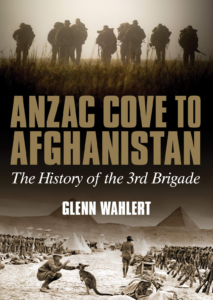
ANZAC Cove to Afghanistan: The History of the 3rd Brigade – Glenn Wahlert
As the first Anzacs to land at Gallipoli on 25 April 1915 and among the last to serve in Afghanistan 100 years later, the men and women of the Australian Army’s 3rd Brigade have a long and proud history. Initially raised in 1903, the 3rd Brigade served as part of the Australian Imperial Force during World War I, suffering appalling losses at Gallipoli. On the Western Front the brigade endured three years of horrendous trench warfare, its four infantry battalions alone incurring a casualty rate of over 300%. During the inter-war period the brigade was a militia force and was mobilised with Japan’s entry into the war in 1941, serving in Darwin, Papua New Guinea and North Queensland. Disbanded in 1944 and re-formed as the 3rd Task Force in 1967, the soldiers of the 3rd Brigade have deployed to almost every theatre in which the Australian Defence Force has seen action, including Vietnam, the South Pacific, Somalia, Cambodia, Rwanda, Bougainville, Timor-Leste, Solomon Islands, Iraq and Afghanistan. From 1980 the brigade has been the government’s land force instrument of first choice in response to military or peacekeeping interventions throughout the world and natural disasters at home. This is a heritage of which all Australians can be justifiably proud.
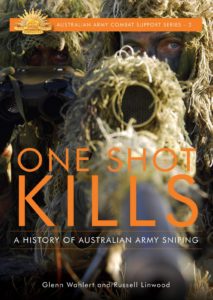
One Shot Kills: A History of Australian Army Sniping by Glenn Wahlert and Russell Linwood.
A sniper is not just a good shot. While marksmanship is crucial, it is not this alone that defines the sniper. Snipers must also be superb bushmen, possess limitless patience, iron discipline, rat cunning, extraordinary stamina and attract more than their share of luck. The well-trained sniper will stalk his enemy or lie in wait for his target to appear. He will eliminate his target with just one shot and escape to repeat his mission time and again. The history of the Australian Army is replete with untold tales of brave men who built reputations as daring and skilful snipers. From the training grounds of the Boer War and First World War, Australian snipers honed their deadly skills and earned a fearsome reputation. In the Second World War they duelled with their German counterparts in the Western Desert and the hardy Japanese snipers of the Pacific War. The valuable lessons of two major wars had to be relearned for the Korean War where ‘naïve young men who knew nothing of combat sniping’ learned quickly or didn’t survive.
The snipers of today’s Australian Army have learned the lessons of history and are held in the same high regard by friend and foe as their Gallipoli forebears. Snipers have become an essential force multiplier and have deployed on every operation since Somalia. One Shot Kills is the story of the sniper’s journey from the South African veldt to the recent battlegrounds of Iraq and Afghanistan. It is also the story of the development of the modern sniper’s combat weapon system in which technology has been harnessed to produce extraordinary results on the battlefield. Australian Army snipers are justifiably regarded as among the best in the world.
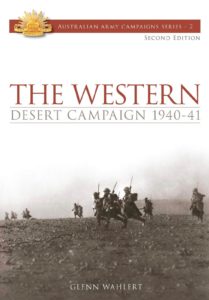
The Western Desert Campaign 1940-41, Second Edition by Glenn Wahlert.
While the North African campaign has been studied in detail over the years, much of this study has been dedicated to the battles between the British 8th Army and Rommel’s Afrika Korps. There has been little serious study of Wavell’s campaign against Italian forces in 1940-41, nor of the role played by the Australian 6th Division in the eventual Italian defeat. Many Italian units showed incredible bravery, and the Australian assaults on fortress towns such as Bardia were far from a walkover.
Today’s aspiring military commanders need look no further than the early Western Desert campaign for historical examples of brilliant leadership, detailed planning, deception, surprise, manoeuvre warfare and relentless pursuit, all against overwhelming odds.
This book is part of the Australian Army History Unit’s Campaigns Series; well-researched, comprehensive and easy-to-read books on Australia’s military campaigns.
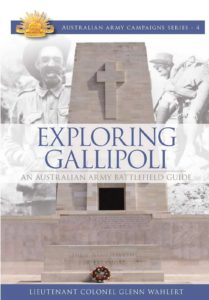
Exploring Gallipoli: An Australian Battlefield Guide by Glenn Wahlert.
This book provides both practical touring information on Gallipoli for the independent traveller, and a guide to the amazing First World War Anzac battlefields.
Written by a serving Australian Army officer with over 30 years soldiering experience, and now a historian with the Australian Army History Unit, Lieutenant Colonel Glenn Wahlert presents a unique view of the campaign and of the key events that occurred on the ground. It includes detailed information on the key sites at Gallipoli, including recommended routes, optional walks and drives, maps, digital images, original art work and even sound files to download on to your MP3 player. Information and suggestions on accommodation, transport, restaurants, entertainment and sightseeing are also provided to enable you to plan your holiday and make the most of your time on the Peninsula.
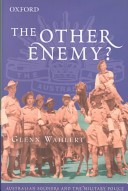
The Other Enemy? by Glenn Wahlert
This book is the first study of Australia’s military police. It traces its history from its roots as the Provost Marshal in the colony of New South Wales, where it was ‘similarly feared by soldier, settler, and convict alike, ‘ through the formation of the Anzac Provost Corps in 1916 and up to the end of World War II.
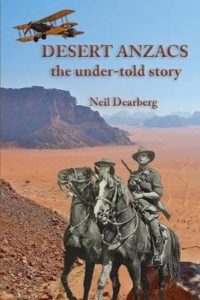 Desert Anzacs the under told story of the Sinai Palestine Campaign 1916 – 1918 by Neil Dearberg. Neil is a graduate of the OCS December 1969 class.
Desert Anzacs the under told story of the Sinai Palestine Campaign 1916 – 1918 by Neil Dearberg. Neil is a graduate of the OCS December 1969 class.
Neil Dearberg was an Army officer for 15 years and principal of a financial planning practice for 23 years before taking up conflict archaeology, military history research and photography. He attended four field projects with the Great Arab Revolt Project of the Bristol University UK and three field trips to assist an American PhD candidate. Focusing on the Sinai Palestine campaign, he has had over a dozen articles published in Australia, Jordan, UK and USA.
For 100 years, the astounding story of Anzac horsemen, cameleers, aviators, rough riders, medics, vets, light and armoured cars hasn’t been told. Until now.
Championed by Australia’s Lieutenant General Sir Harry Chauvel they overcame early feeble British political and military incompetence. Fast, open conflict, rather than septic trenches, suited their outback upbringing. Part of the Egyptian Expeditionary Force, they recovered the Holy Land after 730 years of Muslim control, even saving Lawrence of Arabia and his cause. Their stunning victory at the Battle of Beersheba was the last mass mounted charge of modern times. The ‘great ride’ offensive of the Desert Mounted Corps, with 30,000 horsemen, destroyed the Ottoman Empire and wreaked vengeance for Gallipoli.
This is the first detailed account of the extraordinary military campaign that set the stage for today’s Middle East. Dearberg’s Anzac trilogy on World War I is now complete – Gallipoli, France, Palestine.
Other Books
 The Tiger Tea Club by Harvey Fewings graduate of the Class of December 1967.
The Tiger Tea Club by Harvey Fewings graduate of the Class of December 1967.
The Tiger Tea Club is a delightful adventure story about the lives of some special people in Australia’s Northern Territory during the 1980s. How they live and how they love form part of their astonishing adventure, which is drawn against the exciting backdrop of some of the world’s most spectacular and rugged country. We go with them, from their raffish jazz club in Darwin, The Tiger Tea Club, through the cultural treasures of Darwin life at that time, watch them swim in mysterious, remote gorges where they meet spiritual beings, and fight for their lives in the Arafura Sea as they are tossed about in a violent tropical thunderstorm. We are also introduced to the curious and fascinating world of Piano Mouse.
